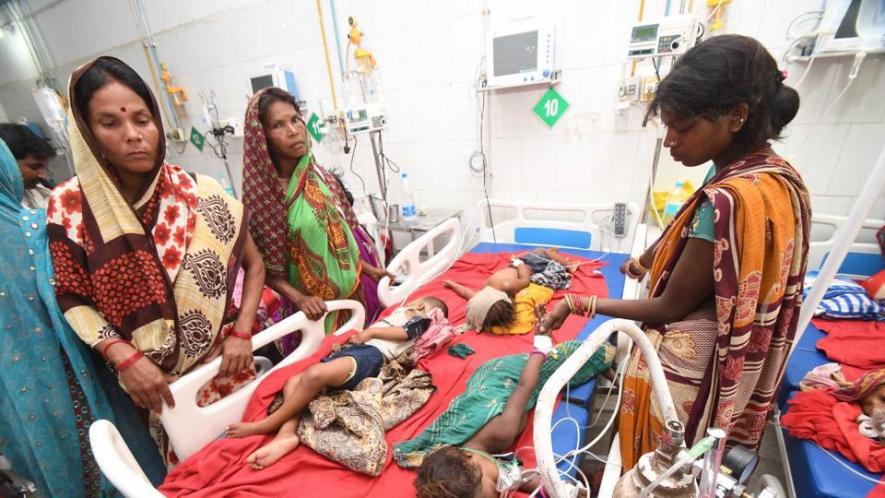Deadly AES Mostly Affected BPL Familes in Bihar's Muzaffarpur: Survey

Patna: A survey conducted by the state government has revealed that the deadly Acute Encephalitis Syndrome (AES) has mostly affected the children from the families living below poverty line (BPL) in Bihar’s Muzaffarpur district in the past five years.
The survey was conducted to gauge the socio-economic condition of the affected families after the menace of AES earlier this year, when it had almost presumed form of an epidemic. According to the official figures, over 185 children’s lives were claimed by AES.
The survey said that 958 families were found to have been affected by the AES in Muzaffarpur between 2014 and 2019. All of them belong to the BPL category—implying that they came from the poorest of the poor families. However, only 123 of these families were provided job cards under the much-hyped Mahatma Gandhi National Rural Employment Guarantee Scheme (MGNREGS) by village mukhias (elected village body head) and concerned government officials.
“What is disturbing is that 42 of 123 families that were provided job cards under MGNREG Act, got work only on 15 days in a year, on average,” said the district official associated with the survey of AES-affected families. It was also revealed that payment of over Rs 1.5 lakh for work completed under MGNREGA by about 25 families was pending till June 2019.
A senior official from the Rural Development Department—who looks after the implementation of the scheme—told NewsClick that C P Khanduja, commissioner, MGNREGS, has sought a written explanation from the district administration in this matter.
This development has come a day after Chief Minister Nitish Kumar’s visit to Muzaffarpur where he had announced that his government is working to ensure that no child dies due to AES from next year. Kumar had also confirmed that AES has been affecting children from poorest of the poor stratum, saying that the government is doing everything possible to end malnutrition among the children.
Earlier, NewsClick had reported that most of the victims of AES were children of landless farm labourers, daily wage workers, seasonal labourers and people earning livelihood by doing odd jobs. Besides, majority of the children affected by the AES this year were living without toilets and were forced to go for open defecation.
In June this year, a socioeconomic survey was also conducted by Jeevika Didis (livelihood sisters) of self help groups (SHGs) working under the Bihar government’s rural livelihood programme, which had revealed that majority of the AES-hit families are poverty stricken and from the lower stratum of the society.
As per the survey, most of the affected children were in the age bracket of 1-11 years. Majority of them were malnourished and living in dalit hamlets like Mushahar Toli, Paswan Toli , Chamar Toli and Muslim hamlets in the villages of Muzaffarpur. Out of the 289 AES-affected families, 96 families had no ration cards, while 124 did not get any food grains through the public distribution system. Majority of those surveyed were deprived of welfare schemes like food security. Only 29 familes were beneficiaries of the Mukhyamantri Kanya Suraksha Yojana and 98 were covered under the Indira Awas Yojana. But not a single family was beneficiary of the much-hyped Jal Nal Yojana (tap drinking water) of the state government. The annual income of the affected families was estimated to be between Rs 30,000 to 70,000.
More than over two decades after AES first struck Muzaffarpur as an epidemic, the disease not only persists, but also continues to spread among the poorer sections. Estimates say that more than 85% of the victims belong to the socially marginalised sectionss—comprising mostly dalits along with Extremely Backward Classes (EBCs) and Muslims.
Though more than half a dozen cases of children suffering from AES were reported in the first week of September in the government-run Shri Krishna Medical College and Hospital (SKMCH) in Muzaffarpur, the disease is not making it to the news anymore. In August too, over a dozen children with AES were admitted to SKMCH, while four of them had died.
In SKMCH, 485 children have been admitted with AES symptoms this year so far and nearly 330 have returned to their homes after treatment, SKMCH officials said.
Also read: Encephalitis Deaths: Bihar’s Healthcare System in ICU
Get the latest reports & analysis with people's perspective on Protests, movements & deep analytical videos, discussions of the current affairs in your Telegram app. Subscribe to NewsClick's Telegram channel & get Real-Time updates on stories, as they get published on our website.
























